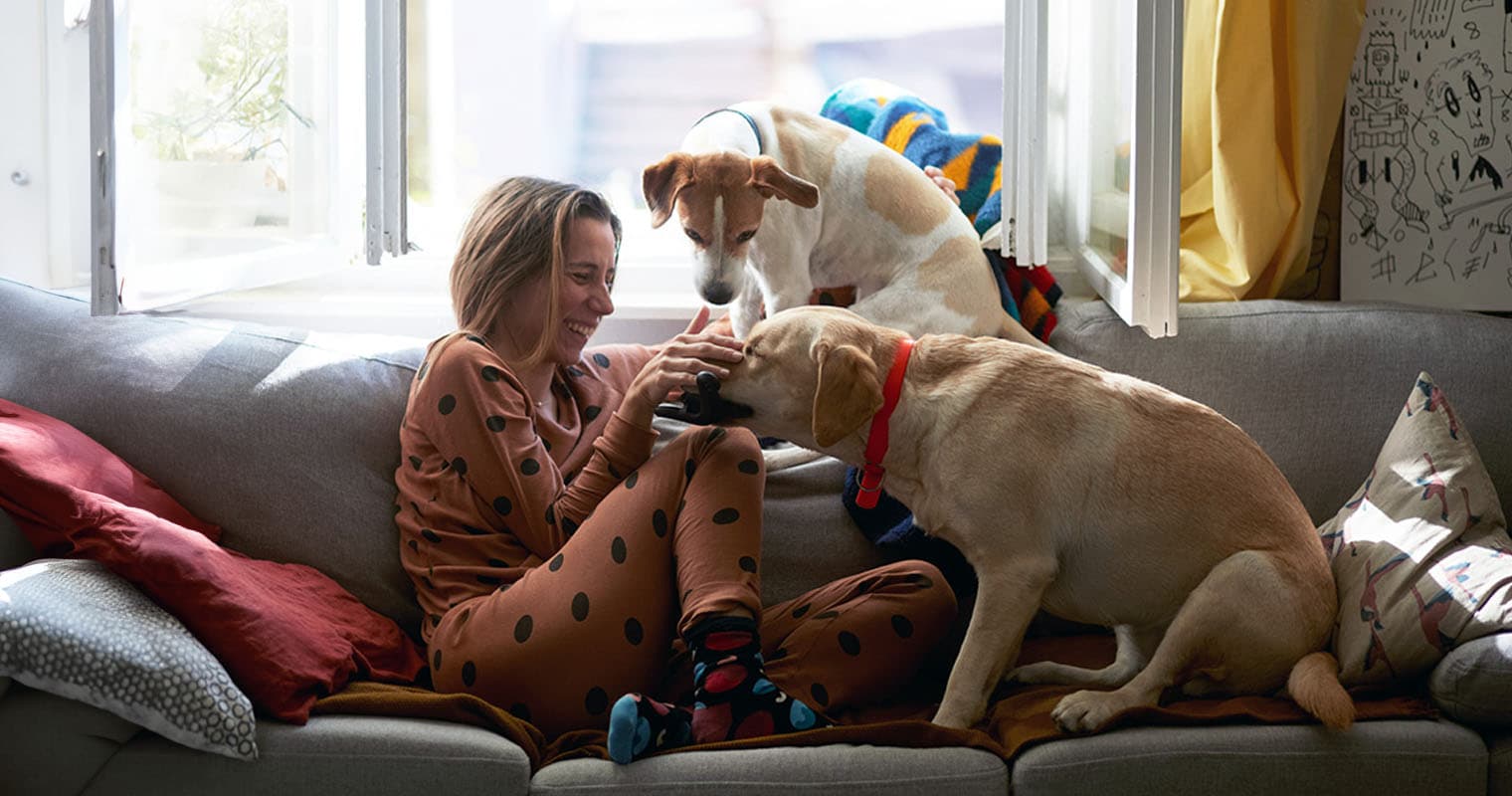Consider Adopting a Bonded Pair
Are you curious about adopting a bonded pair of dogs? Here’s what you need to know about bringing home two pups.
Are you curious about adopting a bonded pair of dogs? Here’s what you need to know about bringing home two pups.
by Daniela Lopez, | March 21, 2024

Boris Jovanovic / Stocksy
Now, more than ever, pets are coming into shelters and rescues in bonded pairs, mostly because of their families’ economic circumstances and lack of housing security. When pets are surrendered in pairs, they run the risk of being adopted into separate homes. This can be heartbreaking to two animals who have created a meaningful bond. So, if you’re considering adopting a dog or a cat, consider adopting two: There are many advantages to adopting a bonded pair. Here’s what you need to know.
A bonded pair means there are two pets available for adoption as a package deal. These pets have formed a tight-knit bond, often due to living together previously. “Bonded pairs are typically close in age, as many have spent their whole lives together,” says Lisa Arden, a senior dog foster mom who has fostered nearly 80 dogs (including 11 bonded pairs) for Muttville SF and Oakland Animal Services. “They often rely on each other for companionship, comfort, and security. If a pair of dogs is truly bonded, it’s best to keep them together.”
While previous shared life experiences are an important indicator, that doesn’t mean all dogs (or cats) who’ve lived together are bonded pairs. Sometimes, pets who have been surrendered from the same household actually do better on their own (such as dog littermates, pets who don’t get along well, or pets who just need to blossom on their own).
And a bonded pair doesn’t have to be pets of the same species. They can actually be a variety of animals (i.e., a dog and cat, an older sibling pair, or a dog and bird — the list goes on and on). Dogs who get stuck at the shelter together for long periods of time can also meet and become bonded.
Shelters and rescues will ultimately decide if a set of dogs are bonded and should be placed together. “It can sometimes be difficult to tell if a pair is truly bonded, or if they just enjoy each other’s company. So, sometimes, rescues or shelters have to test how the dogs do separately,” Arden says. “A pair is truly bonded when separating the pair causes distress and anxiety for both animals.”
Maddie’s Fund created an adoption guideline with a list of 10 potential signs to look for when determining if two dogs are bonded.
They came into the shelter/rescue together.
They have lived together for a long time.
They have been through some type of trauma together.
Their surrender forms indicate they are bonded.
They show closeness, lots of physical contact, or comfort each other.
They show signs of affection, such as licking and cleaning.
They refuse to leave their kennel without each other.
They wait to make sure the other is getting food or treats, too.
They are more withdrawn from human contact without each other.
They might get particularly stressed or anxious when separated.
Cats can become bonded with each other too. While cats can be solitary creatures, companionship is still incredibly important. Cats need social interaction to really thrive. Think of social play as being one of the important pillars for a cat’s health, along with a clean place to poop and pee, food and water, and a comfy place to nap.
It isn’t uncommon for cats to form tight bonds with their housemates — especially those they’ve lived with for many years. Often, these bonded cats will come into the shelters together. They may be more open to human contact when their pal is around, and enjoy curling up next to each other.
Similarly to dogs, bonded cat pairs have lengthier shelter stays because they are more difficult to adopt. Some rescues will prioritize foster homes for potentially bonded pairs of cats so they can better assess their needs.
Here are five ways to identify if cats are bonded:
They groom each other.
They enjoy sleeping on/or near each other.
They enjoy playing together.
They aren’t hissing, fighting, or showing signs of upset when together.
They get anxious when they are separated.
One of the biggest benefits of adopting a bonded pair is that you’re helping them to keep a companion who would be highly traumatic for them to lose; adopting them together ensures they don’t have to go their separate ways. But there are other benefits for you, your family, and the adopted pair, including:
Pairs are healthier: Studies show that animals bonded to one another live longer and healthier lives.
Built-in companionship: When you bring home a bonded pair, you’re providing these pets with a lifelong friend who’s always up to play. “Bonded pairs are wonderful because they have each other to lean on for emotional support,” Arden says.
Reduced separation anxiety: Bonded pairs are less likely to suffer from separation anxiety since they have each other for comfort and reassurance when you’re not around.
Easier transition: When you have a partner who offers stability, the adjustment to a new home can go a little more smoothly. Because they can lean on each other, “it is typically easier for them to adapt to life in a new home,” Arden adds.
It’s a good thing to do: Giving soul mates the opportunity to stay together might also weigh in with some karmic benefits to boot. When shelters separate bonded pairs and adopt one pet, the other pet tends to have a longer stay compared to other pets at the shelter.
If you think that having two companion animals is harder than having one, think again. Many pets engage in destructive behaviors because of boredom or separation anxiety, so adopting a pair of pals can actually end up reducing the number of issues you may have to handle.
A built-in playmate naturally provides the stimulation and security many cats and dogs need to reduce the potential for neurotic behaviors to develop. For pet parents who feel guilty or concerned about leaving their pet alone while at work, having a bonded pair can do a lot to alleviate those concerns.
“When their person is away, they have each other,” says Dr. Gary Weitzman, president and CEO of the San Diego Humane Society, in an interview with The Wildest. “They stay entertained [and] you can feel comfortable knowing that your fur-babies are happy at home.” Dr. Weitzman believes taking care of a bonded pair is nearly as easy as caring for a single pet when they share the same litterboxes, walking schedules, and feeding routines. But there are a few things to consider before adopting a bonded pair:
Do you have enough room in your home for two pets to live comfortably?
If you’re renting, does your lease have any restrictions on the number of pets?
Are you prepared to provide them both with enough exercise and mental stimulation?
Is your family or roommate on board with adopting two pets at once?
Can your budget cover a bonded pair? Two pets mean double the expenses for food, vet care, grooming, litter, and pet sitting.
Do you have a sitter or caregiver who can watch both pets when you’re away?
If you already have pets at home, think about how they’ll feel about the new pair.
While there are definite benefits to adopting pairs, that doesn’t mean bonded pairs don’t come with challenges, too. You’ll need to consider each pet’s unique needs and make sure they both receive proper care, training, and plenty of attention. While being with their bonded companion can help reduce stress, it’s also important that each pet gets individual bonding time with their pet parents. Separate walks and training sessions are a good place to start to build that one-on-one bonding.
And introducing a bonded pair to your current pets can add kinks to an already lengthy process. The general method of introducing pets will be similar to how individual pets are introduced, but both animals will need to be introduced on their own and assessed for feelings of anxiousness or fear. This gradual process will require a lot of patience to ensure a positive relationship develops.
“I suggest bringing resident pets to the shelter or rescue to meet your new pets before adopting if at all possible. This can definitely allow you to see if their personalities match before finalizing the adoption,” Arden says.
If you’ve decided that adopting a bonded pair is right for you, start by contacting local animal shelters and rescue organizations on Adopt a Pet, which has a “bonded pair” filter. Many likely have bonded pairs of dogs and cats desperately in need of loving, caring homes. You can also reach out to a shelter or rescue organization that specializes in caring for “less adoptable” pets.

Daniela Lopez is the content manager at Adopt a Pet. As a content strategist, she has previously contributed to The Bark, The Wildest, and more. She has volunteered for several non-profits, including the Alameda Animal Shelter and Lost Our Home Pet Rescue, and is currently a foster for her local SPCA. In her free time, she has two mixed-breed rescue dogs keeping her on her toes.